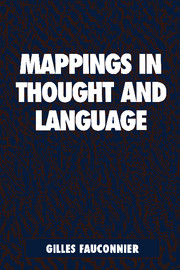
-
Select format
-
- Publisher:
- Cambridge University Press
- Publication date:
- June 2012
- June 1997
- ISBN:
- 9781139174220
- 9780521599535
- Dimensions:
- Weight & Pages:
- Dimensions:
- (228 x 152 mm)
- Weight & Pages:
- 0.31kg, 220 Pages
- Subjects:
- Developmental Psychology, Psychology
You may already have access via personal or institutional login- Subjects:
- Developmental Psychology, Psychology
Book description
Meaning in everyday thought and language is constructed at lightning speed. We are not conscious of the staggering complexity of the cognitive operations that drive our simplest behavior. This 1997 book examines a central component of meaning construction: the mappings that link mental spaces. A deep result of the research is that the same principles operate at the highest levels of scientific, artistic, and literary thought, and at the lower levels of elementary understanding and sentence meaning. Some key cognitive operations are analogical mappings, conceptual integration and blending, discourse management, induction and recursion. The analyses are based on a rich array of attested data in ordinary language, humor, action and design, science, and narratives. Phenomena that receive attention include counterfactuals; time, tense, and mood; opacity; metaphor; fictive motion; grammatical constructions; quantification over cognitive domains.
Contents
Metrics
Altmetric attention score
Full text views
Full text views help Loading metrics...
Loading metrics...
* Views captured on Cambridge Core between #date#. This data will be updated every 24 hours.
Usage data cannot currently be displayed.
Accessibility standard: Unknown
Why this information is here
This section outlines the accessibility features of this content - including support for screen readers, full keyboard navigation and high-contrast display options. This may not be relevant for you.
Accessibility Information
Accessibility compliance for the PDF of this book is currently unknown and may be updated in the future.


